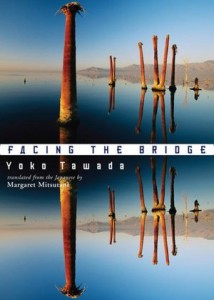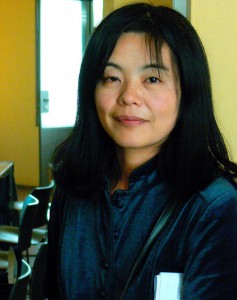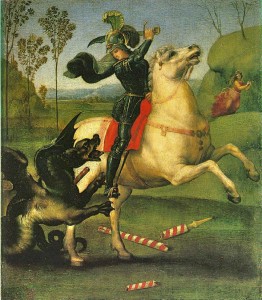“The soul itself does not suffer…It appears to be in pain when a new connection forms, an invasion takes place, or a collision occurs.”
 Though the characters of these three mesmerizing novellas are all looking for “bridges,” they face personal voids instead, gaps between their perceptions of past and the present, and dislocations in time and place. All are hoping to make true connections which will allow them to resolve the conflicting aspects of their inner lives. Each of the characters has traveled to a new place from the “homeland” where she or he was born, and each now lives in a new culture into which she or he does not quite fit.
Though the characters of these three mesmerizing novellas are all looking for “bridges,” they face personal voids instead, gaps between their perceptions of past and the present, and dislocations in time and place. All are hoping to make true connections which will allow them to resolve the conflicting aspects of their inner lives. Each of the characters has traveled to a new place from the “homeland” where she or he was born, and each now lives in a new culture into which she or he does not quite fit.
As these characters deal with the disconnections in their lives, the author creates almost mystical scenes—not quite real and not quite nightmare, with fantasy and reality overlapping, both for the characters and for the reader. The miscommunications and lack of communication that occur among people living in foreign cultures add to the burdens each faces, and as one would expect of these explorations of cultural confusion, each of the novellas ends inconclusively, leaving the “bridges” still to be sought, even by the reader.

The two main characters of “The Shadow Man” are so similar psychologically that they might be considered to be two aspects of the same person, though they come from different backgrounds and times. Amo, based on a historical personage, was brought to Germany from Africa in a “huge floating temple” occupied by Bad Spirits, who seized him at the age of seven and brought him to Germany as a slave of the Duke of Braunschweig. With the Duke as his patron, Amo was educated and became the first African to obtain a Doctor of Philosophy degree from a European university. His attempts to fit into eighteenth century German society are hesitant, and his shyness with women makes relationships tenuous at best.
Interjected with Amo’s story (and introduced without any transitions) is the story of Tamao, a contemporary Japanese national studying in Germany, a man who finds that he belongs neither to the Japanese nor German culture—and who faces many of the same problems as Amo.
“In Front of Tran Tien Bridge” t ells of Kazuko Minamiyama, a Japanese living in Berlin who has been invited to Vietnam by an acquaintance. Because her friend has seen someone in Vietnam who looks just like Kazuko, she travels there on vacation a few years after the “Vietnam” (or “American”) War. Kazuko regards being a tourist as a job, and she is careful to behave exactly as tourists behave, a quiet satire which is well integrated with author Tawada’s themes of miscommunication and alienation. Like Amo and Tamao, Kazuko has sexual relationships which remain unresolved, even as she travels with a blonde young man who identifies himself as “Japanese.” Throughout the trip, Kazuko discovers women who look exactly like her, with more and more of them appearing the longer she stays in Vietnam.
ells of Kazuko Minamiyama, a Japanese living in Berlin who has been invited to Vietnam by an acquaintance. Because her friend has seen someone in Vietnam who looks just like Kazuko, she travels there on vacation a few years after the “Vietnam” (or “American”) War. Kazuko regards being a tourist as a job, and she is careful to behave exactly as tourists behave, a quiet satire which is well integrated with author Tawada’s themes of miscommunication and alienation. Like Amo and Tamao, Kazuko has sexual relationships which remain unresolved, even as she travels with a blonde young man who identifies himself as “Japanese.” Throughout the trip, Kazuko discovers women who look exactly like her, with more and more of them appearing the longer she stays in Vietnam.
“Saint George and the Translator” takes place in the Canary Islands, to which the speaker has gone to work on a translation of a short story about St. George and the Dragon. Living high on a hill overlooking the water, she finds herself unable to work, having too little energy to see the fragments of the manuscript as a whole. Though she walks with the author and converses with her, the translator has not finished the translation as her deadline approaches. Fragments of the story of St. George and the Dragon are interspersed with the action, and symbolic questions arise about the nature of St. George and, even more importantly, the nature of the dragon, and where the translator fits between them. Eventually, she befriends an abusive local ice cream vendor, with whom she finds herself “trapped in the embrace of St. George.”

As the characters constantly examine and re-examine their roles in alien societies and among alien people, they also contribute to the alienation through their behavior, intentionally or not. An aura of sexuality pervades the stories–though it is distanced, almost chaste in its expression–and the reader observes that in this, as in other areas, communication does not take place as one might expect. Featuring characters who are solitary, either by nature or through the circumstances of their lives, these stories bring each character to the point at which she or he must begin to “face the bridge.”
Photos, in order: The author’s photo appears on http://www.wdr3.de
The monument to Anton-Wilhelm Amo by G. Geyer, along with a story about him, may be seen on http://en.citizendium.org
Raphael’s St. George and the Dragon is from http://www.executedtoday.com
